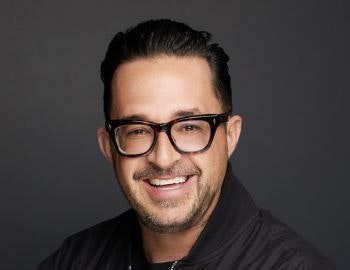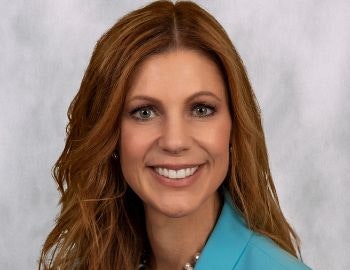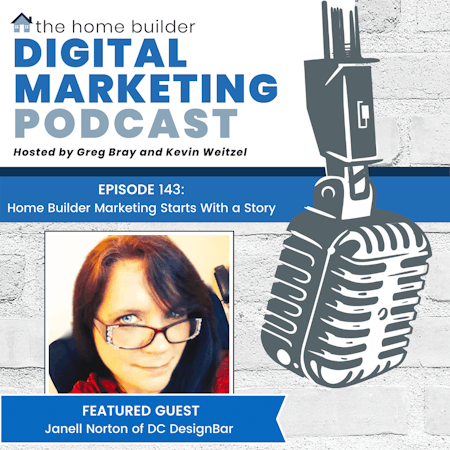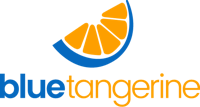143 Home Builder Marketing Starts With a Story - Janell Norton
This week on The Home Builder Digital Marketing Podcast, Janell Norton of DC DesignBar joins Greg and Kevin to discuss why successful home builder marketing starts with a story.
As the homebuilding market transitions back to a marketing-driven environment, home builders need to concentrate on their existing customer base. Janell explains, “…focus on the customers that you already have. Focus on the leads that you already have. Work those leads, and then let's start working into finding those new leads for you. When you start looking at finding those new leads and finding those new home buyers, look at what's working. Look at where your leads are coming from right now and start building your strategy and your campaign around those channels.”
Creating a positive marketing strategy begins with highlighting outstanding aspects of the home builder and telling a story about those features. Janell says, “So, you know when you're planning any campaign and any strategy, especially in the home building arena because it is a longer process, you should have a story that you're telling. You should be telling a story in a way that it connects with your potential home buyer or target audiences.”
Experience matters most to customers and that must be part of the marketing story. Janelle says, “People buy an incredible experience. The price of a home or the price of a product or even the service being offered has become secondary to people. So, when you are in that mass market that a lot of people are in and consume, the story needs to be the exceptional experience you are going to have with that builder.”
Listen this week to learn more about the value of storytelling in marketing.
About the Guest:
Janell is the founder of DC DesignBar, which is an exclusive Marketing Strategy Agency providing leading digital and traditional marketing services to Developers, New Home Builders, and Architects.
Janell has established herself as an industry leader having overseen projects like Union Market DC, Mosaic District Fairfax, Arbor Row Tyson’s, Peninsula 88 at Buzzard Point, Jasper, and Timber Sky.
By managing specific aspects of business development, Janell works exclusively on her client’s behalf to bring new, engaging, interactive marketing collateral to their existing portfolios. Janell’s “creative” nature, combined with her knowledge of advertising and love of technology, led her in the direction of starting a company that helps people enjoy engagement campaigns.
Janell’s career also includes a position as MIS Director, at Sentinel Technologies, managing the national business development and marketing efforts of a renowned IT design firm.
Janell holds a Bachelor of Science degree from Denver Business College. Her expertise and opinions have been featured across many media platforms, including; Discovery Channel, AZ Channel 3, FM Talk Radio, and FrontDoor. She is a frequent speaker on topics such as “Engage” a 2006 webinar series on converting print publications to interactive digital publications that engage the reader and “Reach” 2007 opening niche digital revenue stream to grow distribution as well as subscriber base.
She enjoys golfing, culinary delights, music, writing, and exploring new cities to find their hidden treasures.
Transcript
Greg Bray: [00:00:00] Hello everybody, and welcome to today's episode of The Home Builder Digital Marketing Podcast. I'm Greg Bray with Blue Tangerine.
Kevin Weitzel: And I'm Kevin Weitzel, with OutHouse.
Greg Bray: And we are excited today to welcome Janell Norton to the show. Janelle is the owner of DC DesignBar. Welcome, Janell. Thanks for joining us today.
Janell Norton: Thank you. Glad to be here with you guys.
Greg Bray: Well, Janelle, let's start off by just helping folks get to know you a little bit. Give us a little bit of background. Tell us about yourself.
Janell Norton: All right. So, I'm Janell Norton. I started working with home builders and architects [00:01:00] about 25 years ago from a luxury lifestyle perspective and decided about 10 years ago to focus all of my energy on developers, builders, and designers. So, that has occupied my career space for the last decade, which I've really enjoyed.
Kevin Weitzel: So, that's helping out home builders, but what about your personal world? Can you let our listeners know something about you that doesn't have anything to do with the home building industry?
Janell Norton: Ooh, that's tricky. I love work, so a lot of my life is around work, but I think expanding outside of work, I actually have a very large appetite for design in general. So, a lot of my extracurricular activity is spent doing fashion design where I will actually cut and make the patterns myself and fit them to friends and family. So, I just really love that creative outlet.
That creative outlet then [00:02:00] has spilled into interior design where I work with a lot of realtors to stage homes that they're getting ready to put on the market. Which is a little bit related to the industry, but I spend an awful lot of time just being creative. My father was a publisher, so I've fallen into his footsteps and do quite a bit of writing. I did a lot of writing in the past regarding different industries for different news outlets. Yeah, so just kind of a pretty creative person in general.
Greg Bray: On the fashion side, do you have a particular style? Are you like, evening gowns or workout clothes or, I mean, is there some area that you specialize in?
Janell Norton: You know, there's kind of a little bit of everything. I think the cool part of fashion design is I have always been an advocate for finding what is unique about a person and their personality and clothes is a great way to express that. So, it's not really about a couture or a trend or [00:03:00] one style in particular. It's about who is that person and what best expresses their personality and who they are through their clothing.
Kevin Weitzel: I have no fashion sense, but what I love doing is hanging out with bar hags that literally just bag on people that walk by in their clothing. They're like, ew, as if she left home thinking that looked good.
Greg Bray: And when you talk about recognizing people from their clothes when Kevin wears that leisure suit, what does that tell you about him, right? Well, um, we won't make you answer that question.
Janell Norton: That leisure suit is a complete disguise. Like, that is trouble all the way right there.
Greg Bray: So, Janelle, how did you decide that you wanted to get into the home building space? What attracted you or pointed your career in that direction?
Janell Norton: I have always had a fascination with architecture and the way that architecture plays [00:04:00] into our lifestyles congregation, how we kind of move within society itself through our architecture. That interest turned into an overwhelming desire in wanting to be a part of people's lives through their home because most things start and end in your home, including your day. Your most precious memories, most of them, are surrounded around home and family. Being a part of people's journeys in home and in family and in creating those moments that are the most important to them just became not only a passion but a humanitary desire.
Greg Bray: Nice. Nice. Well, it is actually something that sometimes we forget, right? The power of this particular product and industry and what it means for people when you're talking about their home.
Janell Norton: Yeah. It's something that I, when I work with my builders and I help my builders, I try to [00:05:00] remind them, and generally start with, we are literally in the business of building lives.
Greg Bray: It's a great reminder. Well, Janell, tell us a little bit more about DC DesignBar and the kinds of things that you do there, and what type of work you do to help your builders.
Janell Norton: So, DC DesignBar came about from really needing to take a deep dive into the strategies, the overall arching marketing strategy that goes into home building because the home building process and buying a new home is not like walking into a retail outlet, grabbing a pair of sneakers off of the shelf and walking away. It's a long and complex process.
Sometimes I think that as an industry, we haven't done the best job that we could do in preparing a person for what a normal end-to-end, new home buying journey looks like. Because there are so many moving parts, that [00:06:00] journey is longer, it's more expensive than a normal purchase, or going to the store, like I said, and picking out something and walking away.
Like, when you are committing to a new home, you're committing to a process that could take anywhere from seven months to over two years. It's not only imperative that we help the new home buyer get through that journey, we also need to help the home builder get through that journey and we need to help them understand their market, understand their restrictions, understand how all those pieces are going to come together for them.
So, like in some areas, let's take Phoenix for an example. It's easier to get trades to work and build in Phoenix than it is to get trades to work and build in Northern Arizona where the weather plays a little bit more of a part in that building process and how quickly it can or cannot happen. [00:07:00] It's also more rural for trades. So, you know, it's easier for trades to be in the Phoenix area knowing that they have an abundance of work, where if they move to the more northern areas of Arizona, it's harder to get the supplies and the workflow that they are expecting.
Kevin Weitzel: And not to mention, there's a lot more hippies in Flagstaff than there are in Phoenix.
Greg Bray: Don't alienate our audience, Kevin.
Kevin Weitzel: I’m not. My son is a proud, my son's a proud graduate of NAU. It's a, it's a great, great area, but no, she's right and it is, it gets freezing colder in the winter and they get a lot more wind. Yeah. It's not as fun to work there. Although the summer months, I'd argue that it's probably much nicer to work in Flagstaff than in Phoenix.
Janell Norton: I agree with that. You know, but we also have fluctuations through the industry that sometimes builders don't readily identify, which is if you are a builder in Flagstaff, [00:08:00] somewhat in Prescott, you're dealing with, now you're moving into what we consider a vacation region. Which means that, especially in Flagstaff, more than 50% of the homeowners, it's a second home for them. It's a vacation home. It's an investment home.
So, Flagstaff does not have as many residents living in the area as they do people who are there seasonally or on occasion, and that brings a whole different dynamic into your marketing strategy, how you're reaching out to those target audiences that are most likely to buy in your region. Where, in the larger metropolitan areas, you know, you're dealing with people who are residents of that area and plan to live in the community full time.
Kevin Weitzel: That's pretty much my question, which is how do you change your messaging, and do you use different vehicles to get that message to your potential buyers?
Janell Norton: Yes. So, when you're dealing with vacation [00:09:00] regions your digital presence and what the home buyer can do on the computer or on the phone is more relative to the journey because what we find is that people don't necessarily want to fly from Toronto to Flagstaff every few months to figure out what's going on with their homes. So, all of the digital platforms that we've been introduced to or that are becoming more popular, become more important in our vacation regions.
So, things like 3D photo realistic virtual tours are more important. Online design centers are more important. The financial transactions, being able to do those online is more important because it's more convenient for people who are buying a second home or a vacation home to do those things in the comfort of their own home versus [00:10:00] needing to buy a ticket, rent a car, find time to get off of work, and work around their life schedules to come to the region to see those things. So, I think especially post-COVID, we're not only seeing that those things are important in the vacation areas, but they're also becoming more important to the new home buyer in general.
Greg Bray: So, as you talk to builders about, you know, some of these marketing activities and nuances and differences, where are you seeing the builder marketing knowledge, so to speak? Because it feels like over the last few years, builders haven't had to market very much, and there's even people that have come into the industry, you know, with lack of need to market. So, they've never learned how, and now over the last few months, that's dramatically changed with interest rates and the way the market has transitioned, shall we say, so dramatically. Where do they even start when they haven't been doing it to kind of get going again if you will?[00:11:00]
Janell Norton: So, I think the number one thing for builders to keep in mind is they need to focus on the customers they already have. That's going to be across a wide breadth in that builders in general have so many leads that they have collected over the past two and a half years, they need to run through those leads. They need to remember those people. They need to remember that they had an interest, that they did engage, that a lot of them didn't move forward because builders were not able to meet the supply and demand. Even though the market has turned, there's definitely people in those funnels that can be revived and who would like to purchase your home.
So, I would focus on the customers that you already have. Focus on the leads that you already have. Work those leads, and then let's start working [00:12:00] into finding those new leads for you. When you start looking at finding those new leads and finding those new home buyers, look at what's working. Look at where your leads are coming from right now, and start building your strategy and your campaign around those channels.
Greg Bray: Do you have any key metrics that you watch? When you say look at what's working, how do you start to measure the effectiveness of a particular marketing effort?
Janell Norton: So, there's a lot of AB testing that goes on. So, generally, when I launch a campaign I don't launch it horizontally. I launch it parallel to one or two other campaigns to find out what message is going to be most effective. The beautiful part about our digital world is we can collect that information across every channel in which we have a presence. So, I use not just one analytic [00:13:00] tool. You know, Google Analytics obviously being one of the most popular, but I use about two or three different analytical tools that help me really narrow in on what's working the best.
One of the misconceptions that a lot of builders have is, Oh well, look, our Zillow feeds had 300,000 visitors last month. But it's not about the number of visitors you have. It's not about the number of people who clicked on that floor plan. It's about the conversion rate. So, even if they visited Zillow and they opened your floor plan and they didn't convert, it might not be your strongest lead. It might not be the area where you want to spend the most amount of money. Even though you're getting the most amount of visitors, are you getting the most amount of conversions from Zillow?
I find a lot of times we can find what we call niche revenue streams [00:14:00] where maybe the visitors aren't as high. So, for example, I'll just use New Home Directory, which is a smaller listing service. It consists of nothing but new home buyers. A builder may only have 47,000 visitors to their ad on New Home Directory, but New Home Directory tends to convert at a much higher rate because it's a niche market. It's people who are specifically looking for that new home. They're not looking for resale. They want to find that builder that fits their lifestyle and their needs, and it's easier to do that on New Home Directory than it is sorting through the hundreds and thousands and millions of listings on Zillow.
When you are marketing and when you are marketing in the areas that you're building in, you don't only [00:15:00] want to take a look at those big national conglomerates, which you do want to be on and you do want a presence, but you also want to see what your area offers that might give you more focused exposure to the home buyer and your target audience than the big listing service who's appealing to everyone.
Greg Bray: So it sounds like then the mistake you're talking about is going for volume versus quality in that lead source. Are there other kinds of key mistakes you've seen builders make in some of their marketing or in how they're trying to measure their marketing that come to mind?
Janell Norton: Yeah, doing something just because the competition is doing it.
Greg Bray: Oh, that's a good one. Yeah.
Kevin Weitzel: Hey, those guys down the road are doing this. Why aren't we doing this team?
Greg Bray: The people with the flipping the signs on the corner, right? That's where they all came from. Everybody else saw, hey, we should get one of those.
Kevin Weitzel: That's right. They have a wacky inflatable flailing tube arm man. Why don't we have one of those?
Janell Norton: Yeah. You know, and I'm going [00:16:00] to use social media as an example for that. Just because Bob the Builder down the street is using social media. It doesn't necessarily mean you should be using social media in the same way that Bob's using social media. Another mistake that I think a lot of builders make is they do jump into doing what their competition is doing in the market without thinking about what it requires.
So, when you're making a commitment to social media, when you're making a commitment to paid advertising, do you have the assets that you need to be successful? Do you have the photography? Are you committed to the photography? Are you committed to providing great floor plans? Are you committed to sitting down and making a storyboard? I think what most builders miss on social media is they're not really planning it. They're not storyboarding it. You know, and the [00:17:00] storyboarding process of social media is very important. Otherwise, it just looks like you're taking spaghetti and throwing it against the wall.
Greg Bray: Which might be what your competitor's doing, right? Just throwing spaghetti at the wall and now you're copying that.
Janell Norton: Right. So, you know when you're planning any campaign and any strategy, especially in the home building arena because it is a longer process, you should have a story that you're telling. You should be telling a story in a way that it connects with your potential home buyer or target audiences.
I think one of the key elements in marketing and marketing successfully is that we purchase off of some key emotions. That's what makes us finally decide to pull the trigger and say I'm going to buy that pair of shoes. I'm going to take this vacation. I'm going to commit to buying this home. That commitment happens at the point where that [00:18:00] desire to buy that home from that home builder turns from a desire to a need.
There's no, I want this because they can put the bathroom in the corner of the bedroom that I want and nothing else will do. You know, so it's really learning how to, in your campaigns, in your stories that you're telling, in the materials that you are putting in front of the home buyer, whether it be digital or physical, they're emotionally connecting to
Greg Bray: So Janelle, can we peel that back another layer? When you talk about telling a story, can you give more examples of how you would connect a story across maybe some different marketing activities or campaigns to help us understand that a little better?
Janell Norton: So, a story should always be consistent. What makes your story more interesting than the other [00:19:00] person's story? So, where I start with those stories is at the very beginning of positioning a community within a region, and that is what makes it different. What are the true unique identifiers?
So, is it that it's a dark-sky community? There's only 11 in the world, and what does a dark sky community mean? It means you can walk out into your backyard, look up at the sky, and it is so breathtaking. There's not a star that you will miss because the community's been developed with paints and lighting that have minimal reflections so that you just see that darkness that make those stars illuminate. And we start building a story around that sky and we start building a story around, well, the community is just nestled between all these amazing hiking trails that will connect you clear to the other side of town.
Or we're now gonna take the hiking [00:20:00] trails and we're gonna expand them to be a multi-purpose trail that students can use to ride scooters or skateboards to the university that's only a mile and a half away. Clear to, you know, nature at your doorstep. You walk out the front door and you're surrounded by beautiful forest and resident raccoon, and maybe even a resident skunk, and the deer who are more than comfortable to come and eat on your grass. So, it's what truly makes that community unique and you start building that story.
A really good example of that is a community that we just actually finished, we closed out, called Willowford, Virginia. It was a unique community because it had a lot of extra land that needed to be developed, and the city came in and said we do not need one more golf course. We're not gonna approve all of this extra beautiful community area [00:21:00] for a golf course. You have to come up with something different. The land was really lush and had great soil.
So, we came up with a farm-to-table community and we built the community around a resident farm. We put in a market and we put in some great community areas, stables, and the residents have the opportunity to work the gardens and to work the stables, and in return, they are provided with food from the gardens. They're able to take riding lessons. They can have their kids raise animals similar to 4-H. The marketing campaign that went around that was completely about being able to live in this farming community. Not only live in this farming community but participate in this farming community while having all of the beautiful conveniences of modern kind of city life.[00:22:00]
Kevin Weitzel: So, we have one of those in Arizona called Agritopia, which was pretty cool, but what does a builder do with their messaging when they have none of that to talk about? Is it just about the price? You know, 'cause they're using the same two-by-fours, they're using the same drywall. What messaging can a builder do when they don't have any of those unique stories to tell?
Janell Norton: When it's just about a regular kind of spec-type community?
Kevin Weitzel: Yeah, like if it's a spec community and there's like literally a nothing burger about the neighborhood. There's no amenities. It's literally just stick and stucco home. You know, you can get in at x dollar amount. Yes, you're living in a less-than-desirable area. You know, if enough people buy here, then it will become more desirable. How do you tell that story? Is there a story to tell?
Janell Norton: In that case, there's definitely still a story. I mean, you understand that it's not about an extraordinary lifestyle, or it's not about a different type of lifestyle. It's about what everyone else in the community is [00:23:00] doing at that point or another. The story and the marketing comes down to being able to offer the best customer experience available in that market.
People buy an incredible experience. The price of a home or the price of a product or even the service being offered has become secondary to people. So, when you are in that mass market that a lot of people are in and consume, the story needs to be the exceptional experience you are going to have with that builder.
Greg Bray: Well, Janelle, we appreciate your thoughts and insights, want to be respectful of your time. Just a couple more questions though. When you are trying to find inspiration for ideas or looking for those stories and things, where do you go for inspiration and what kinds of things are you looking at?
Janell Norton: So, I always try to, here again, just similar to fashion designing, look for [00:24:00] those parts of the home or the process or the builders that are truly unique. Every builder has something that stands out, has something that makes them different. Whether that's a passion for maybe the wood railing they put throughout the home, or it's a passion for really offering that artisan kitchen in every home, or it's a desire to want every bathroom to be tranquil. Those are the types of unique identifiers that I look for to help a builder sell their product and set themselves apart.
Greg Bray: So, do you have any kind of last words of marketing advice that you wanted to share today with our listeners?
Janell Norton: I do, and that's for the builders to understand that our industry is changing, to understand that post-COVID, we're at a [00:25:00] crossroads. Buyers want to be able to have more control over their home buying journey than they did in the past. Meaning that they want to be able to sit down on their couch and do those virtual walkthroughs on their computer. They want to be able to play with their options on that computer and see what they'll look like. They want to be able to have a home tour on their own terms during the times that work best for them, and without a salesperson present most of the time at the very beginning.
They found that people enjoy being able to walk through a model without having the pressure of a salesperson, and if they are interested in buying, they generally make a call to a salesperson within 30 minutes of doing that self-guided tour. So, really embracing the technology around our industry that will help the home buyers take more [00:26:00] control of that journey.
Greg Bray: Great advice. Great insights. Well, if someone wants to reach out and connect with you, Janell, what's the best way for them to get in touch?
Janell Norton: Visit my website. Send me an email, dcdesignbar.com.
Greg Bray: Awesome. Well, thanks again for sharing with us today, and thank you everybody for listening to The Home Builder Digital Marketing podcast. I'm Greg Bray with Blue Tangerine.
Kevin Weitzel: And I'm Kevin Weitzel with OutHouse. Thank you.
Related Episodes We Think You'll Like

96 Making Analytics Cool Again - Mila Sorenson
This week on The Home Builder Digital Marketing Podcast, Mila Sorenson of Blue Tangerine joins Greg and Kevin to discuss the ins and outs of analytics and why analytics should be an essential part of every digital marketing strategy.

130 Digitizing the Home Buying Process - Jason Hardy
This week on The Home Builder Digital Marketing Podcast, Jason Hardy of Ownly joins Greg and Kevin to discuss digitizing the home buying process and the advantages it has for builders and customers.

250 Personalizing Home Builder Marketing - Brian Newquist
This week on The Home Builder Digital Marketing Podcast, Brian Newquist of Kovach Marketing joins Greg and Kevin to discuss the importance of personalizing home builder marketing to create a stronger connection with home buyers.

128 Providing Digital Information Effectively - Char Kurihara
This week on The Home Builder Digital Marketing Podcast, Char Kurihara of DRB Group joined Greg and Kevin to discuss how to provide digital information that will benefit both the home builder and the home buyer.




